BA3UK90O: Applying Motivation Theories in Modern Workplace Context
VerifiedAdded on 2023/06/10
|8
|2017
|289
Report
AI Summary
This report provides a comprehensive analysis of motivation theories and their practical application in the modern workplace. It delves into key motivational theories such as Maslow's Hierarchy of Needs, Herzberg's Motivation-Hygiene Theory, and Argyris' Theory, evaluating their strengths, weaknesses, opportunities, and threats through SWOT analysis. The report examines how organizations can leverage these theories to enhance employee morale, increase productivity, and foster a positive work environment. Furthermore, it explores the role of Human Resource Management (HRM) in implementing motivational strategies to improve employee participation, promote harmony, and reduce turnover. The conclusion emphasizes the importance of motivation in developing emotional intelligence and achieving organizational success, highlighting the need for HR managers to adopt effective motivational practices to gain a competitive edge.
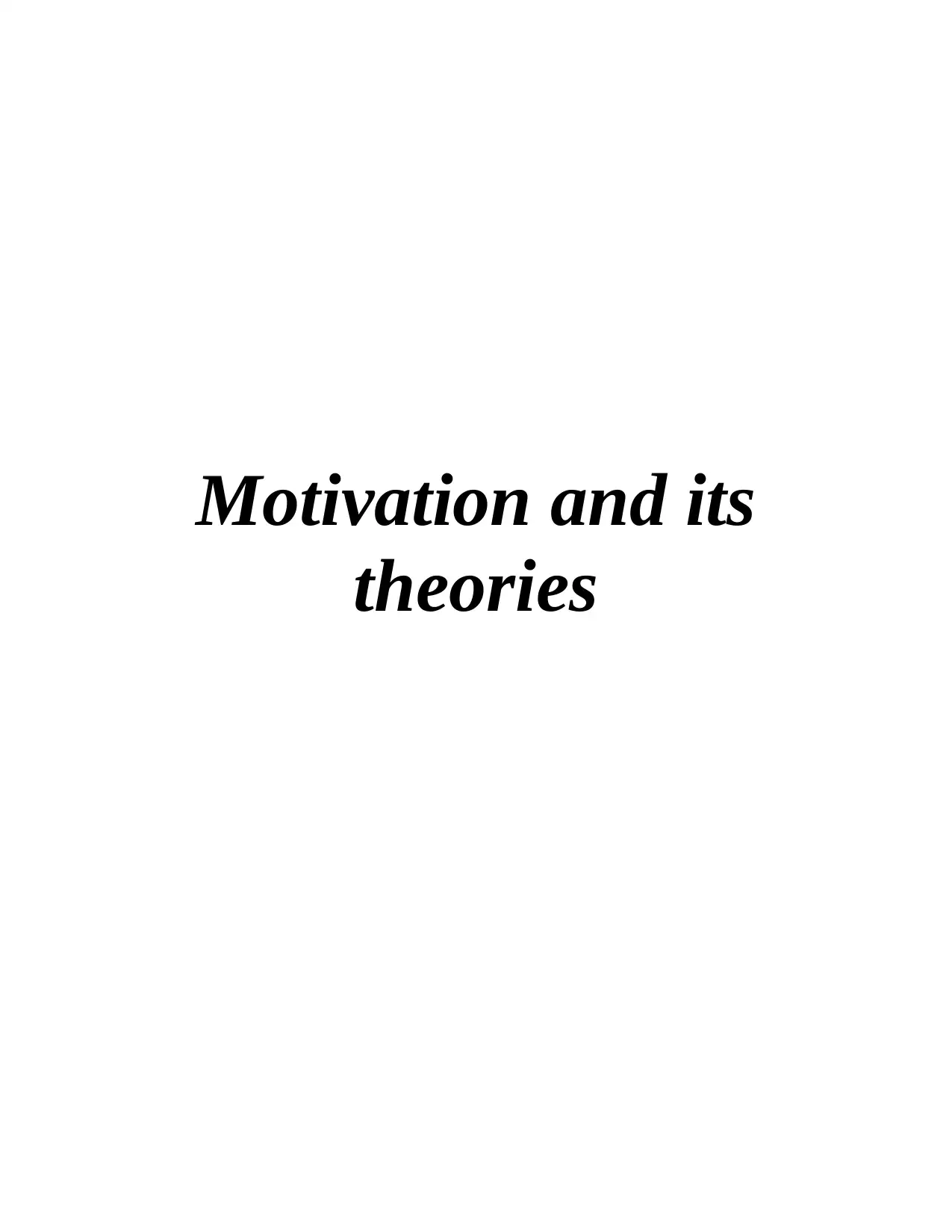
Motivation and its
theories
theories
Paraphrase This Document
Need a fresh take? Get an instant paraphrase of this document with our AI Paraphraser
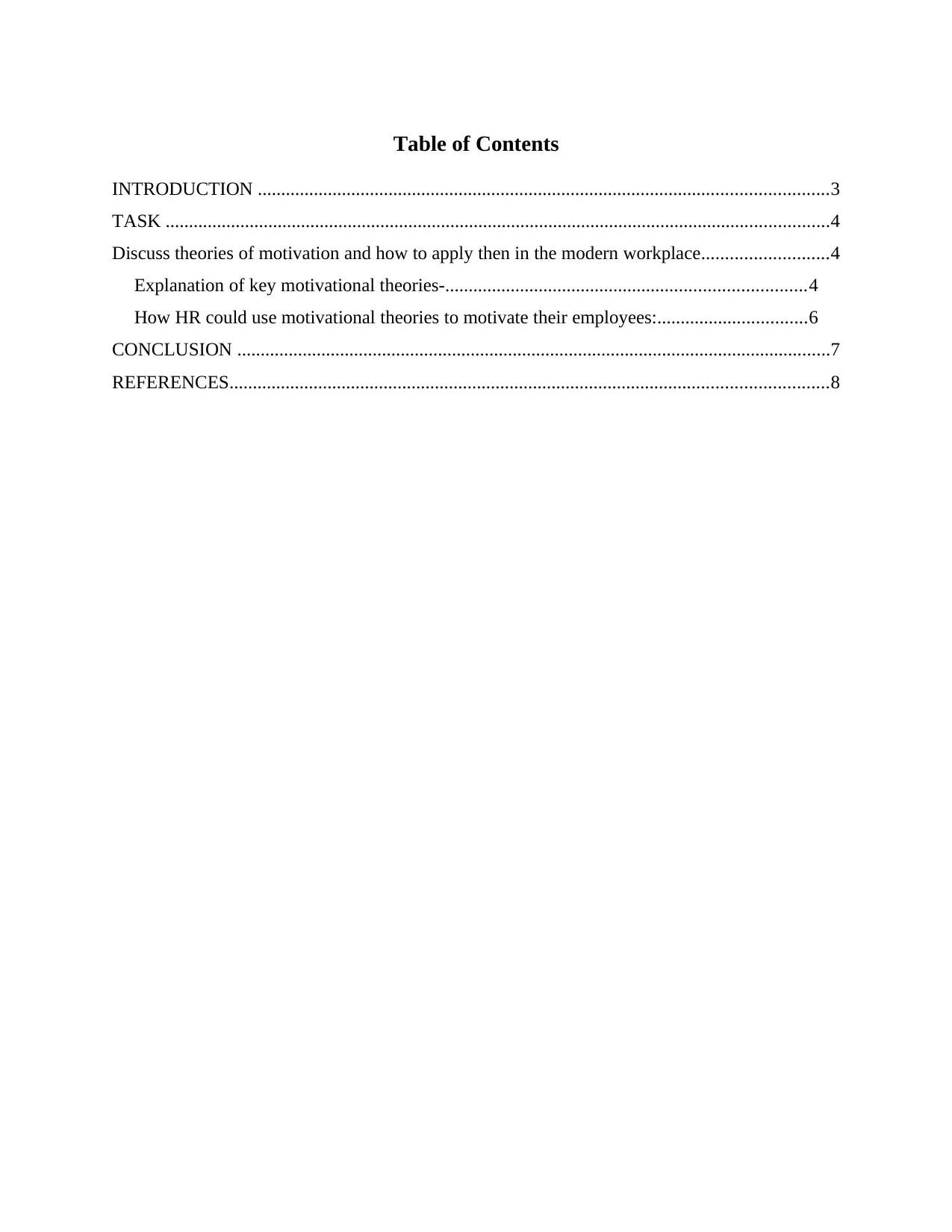
Table of Contents
INTRODUCTION ..........................................................................................................................3
TASK ..............................................................................................................................................4
Discuss theories of motivation and how to apply then in the modern workplace...........................4
Explanation of key motivational theories-.............................................................................4
How HR could use motivational theories to motivate their employees:................................6
CONCLUSION ...............................................................................................................................7
REFERENCES................................................................................................................................8
INTRODUCTION ..........................................................................................................................3
TASK ..............................................................................................................................................4
Discuss theories of motivation and how to apply then in the modern workplace...........................4
Explanation of key motivational theories-.............................................................................4
How HR could use motivational theories to motivate their employees:................................6
CONCLUSION ...............................................................................................................................7
REFERENCES................................................................................................................................8
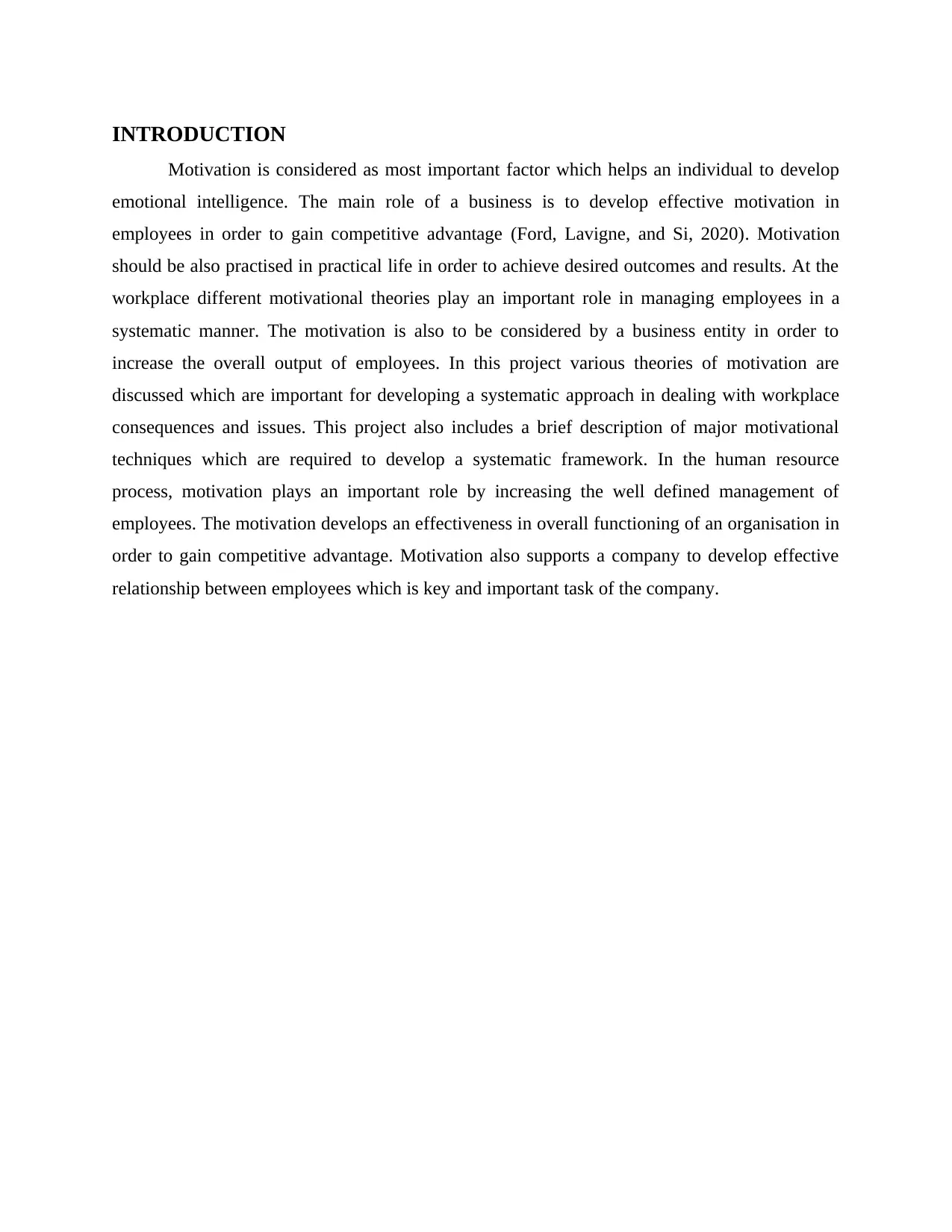
INTRODUCTION
Motivation is considered as most important factor which helps an individual to develop
emotional intelligence. The main role of a business is to develop effective motivation in
employees in order to gain competitive advantage (Ford, Lavigne, and Si, 2020). Motivation
should be also practised in practical life in order to achieve desired outcomes and results. At the
workplace different motivational theories play an important role in managing employees in a
systematic manner. The motivation is also to be considered by a business entity in order to
increase the overall output of employees. In this project various theories of motivation are
discussed which are important for developing a systematic approach in dealing with workplace
consequences and issues. This project also includes a brief description of major motivational
techniques which are required to develop a systematic framework. In the human resource
process, motivation plays an important role by increasing the well defined management of
employees. The motivation develops an effectiveness in overall functioning of an organisation in
order to gain competitive advantage. Motivation also supports a company to develop effective
relationship between employees which is key and important task of the company.
Motivation is considered as most important factor which helps an individual to develop
emotional intelligence. The main role of a business is to develop effective motivation in
employees in order to gain competitive advantage (Ford, Lavigne, and Si, 2020). Motivation
should be also practised in practical life in order to achieve desired outcomes and results. At the
workplace different motivational theories play an important role in managing employees in a
systematic manner. The motivation is also to be considered by a business entity in order to
increase the overall output of employees. In this project various theories of motivation are
discussed which are important for developing a systematic approach in dealing with workplace
consequences and issues. This project also includes a brief description of major motivational
techniques which are required to develop a systematic framework. In the human resource
process, motivation plays an important role by increasing the well defined management of
employees. The motivation develops an effectiveness in overall functioning of an organisation in
order to gain competitive advantage. Motivation also supports a company to develop effective
relationship between employees which is key and important task of the company.
⊘ This is a preview!⊘
Do you want full access?
Subscribe today to unlock all pages.

Trusted by 1+ million students worldwide
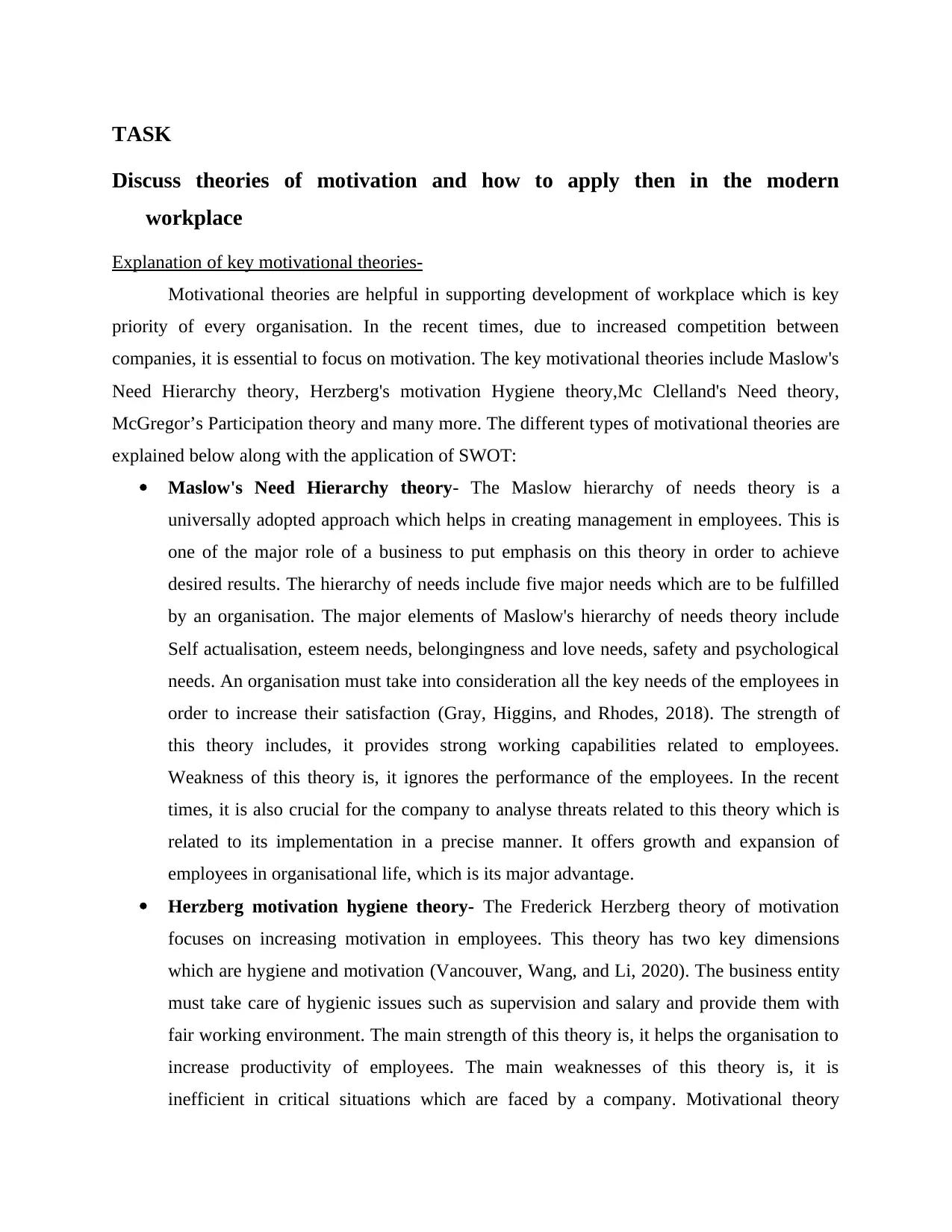
TASK
Discuss theories of motivation and how to apply then in the modern
workplace
Explanation of key motivational theories-
Motivational theories are helpful in supporting development of workplace which is key
priority of every organisation. In the recent times, due to increased competition between
companies, it is essential to focus on motivation. The key motivational theories include Maslow's
Need Hierarchy theory, Herzberg's motivation Hygiene theory,Mc Clelland's Need theory,
McGregor’s Participation theory and many more. The different types of motivational theories are
explained below along with the application of SWOT:
Maslow's Need Hierarchy theory- The Maslow hierarchy of needs theory is a
universally adopted approach which helps in creating management in employees. This is
one of the major role of a business to put emphasis on this theory in order to achieve
desired results. The hierarchy of needs include five major needs which are to be fulfilled
by an organisation. The major elements of Maslow's hierarchy of needs theory include
Self actualisation, esteem needs, belongingness and love needs, safety and psychological
needs. An organisation must take into consideration all the key needs of the employees in
order to increase their satisfaction (Gray, Higgins, and Rhodes, 2018). The strength of
this theory includes, it provides strong working capabilities related to employees.
Weakness of this theory is, it ignores the performance of the employees. In the recent
times, it is also crucial for the company to analyse threats related to this theory which is
related to its implementation in a precise manner. It offers growth and expansion of
employees in organisational life, which is its major advantage.
Herzberg motivation hygiene theory- The Frederick Herzberg theory of motivation
focuses on increasing motivation in employees. This theory has two key dimensions
which are hygiene and motivation (Vancouver, Wang, and Li, 2020). The business entity
must take care of hygienic issues such as supervision and salary and provide them with
fair working environment. The main strength of this theory is, it helps the organisation to
increase productivity of employees. The main weaknesses of this theory is, it is
inefficient in critical situations which are faced by a company. Motivational theory
Discuss theories of motivation and how to apply then in the modern
workplace
Explanation of key motivational theories-
Motivational theories are helpful in supporting development of workplace which is key
priority of every organisation. In the recent times, due to increased competition between
companies, it is essential to focus on motivation. The key motivational theories include Maslow's
Need Hierarchy theory, Herzberg's motivation Hygiene theory,Mc Clelland's Need theory,
McGregor’s Participation theory and many more. The different types of motivational theories are
explained below along with the application of SWOT:
Maslow's Need Hierarchy theory- The Maslow hierarchy of needs theory is a
universally adopted approach which helps in creating management in employees. This is
one of the major role of a business to put emphasis on this theory in order to achieve
desired results. The hierarchy of needs include five major needs which are to be fulfilled
by an organisation. The major elements of Maslow's hierarchy of needs theory include
Self actualisation, esteem needs, belongingness and love needs, safety and psychological
needs. An organisation must take into consideration all the key needs of the employees in
order to increase their satisfaction (Gray, Higgins, and Rhodes, 2018). The strength of
this theory includes, it provides strong working capabilities related to employees.
Weakness of this theory is, it ignores the performance of the employees. In the recent
times, it is also crucial for the company to analyse threats related to this theory which is
related to its implementation in a precise manner. It offers growth and expansion of
employees in organisational life, which is its major advantage.
Herzberg motivation hygiene theory- The Frederick Herzberg theory of motivation
focuses on increasing motivation in employees. This theory has two key dimensions
which are hygiene and motivation (Vancouver, Wang, and Li, 2020). The business entity
must take care of hygienic issues such as supervision and salary and provide them with
fair working environment. The main strength of this theory is, it helps the organisation to
increase productivity of employees. The main weaknesses of this theory is, it is
inefficient in critical situations which are faced by a company. Motivational theory
Paraphrase This Document
Need a fresh take? Get an instant paraphrase of this document with our AI Paraphraser
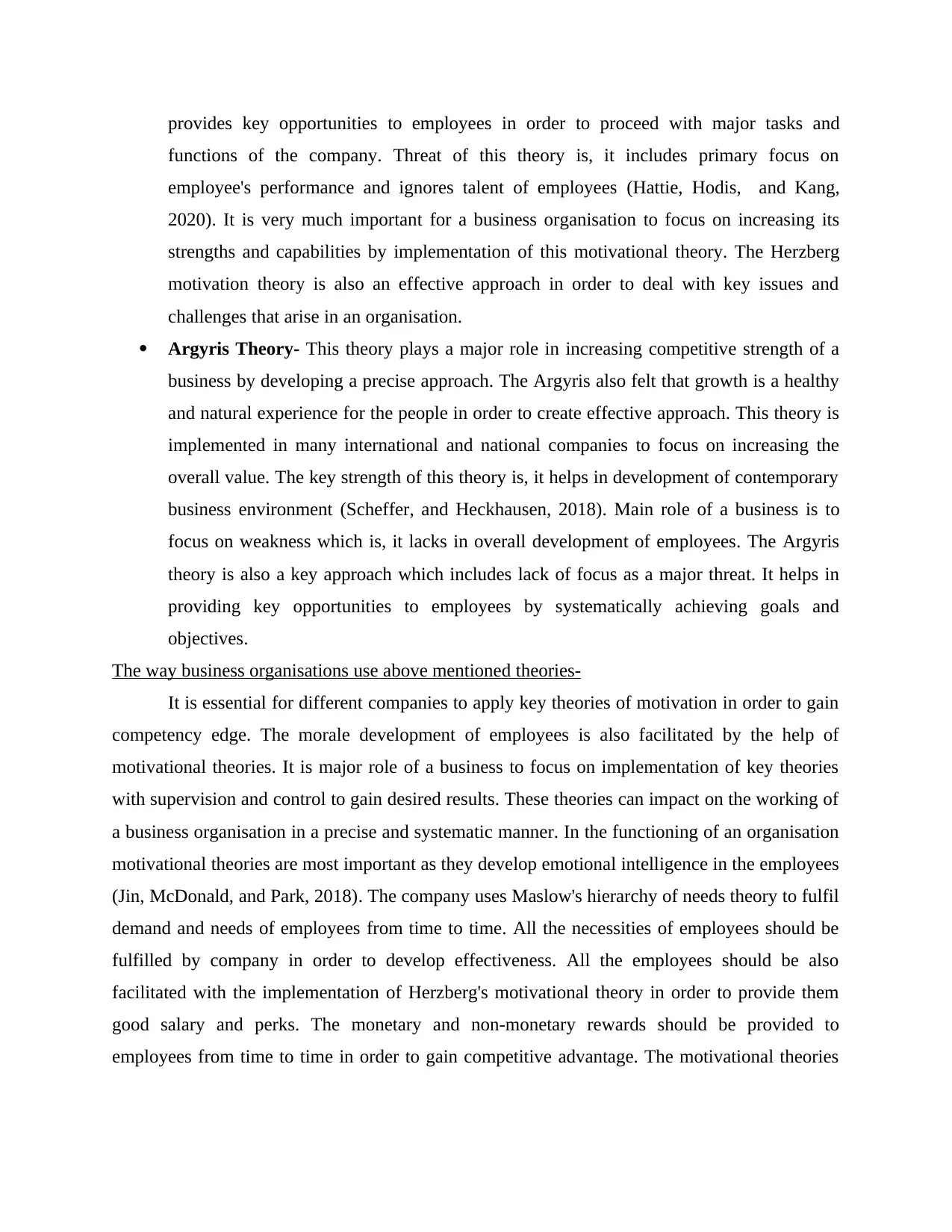
provides key opportunities to employees in order to proceed with major tasks and
functions of the company. Threat of this theory is, it includes primary focus on
employee's performance and ignores talent of employees (Hattie, Hodis, and Kang,
2020). It is very much important for a business organisation to focus on increasing its
strengths and capabilities by implementation of this motivational theory. The Herzberg
motivation theory is also an effective approach in order to deal with key issues and
challenges that arise in an organisation.
Argyris Theory- This theory plays a major role in increasing competitive strength of a
business by developing a precise approach. The Argyris also felt that growth is a healthy
and natural experience for the people in order to create effective approach. This theory is
implemented in many international and national companies to focus on increasing the
overall value. The key strength of this theory is, it helps in development of contemporary
business environment (Scheffer, and Heckhausen, 2018). Main role of a business is to
focus on weakness which is, it lacks in overall development of employees. The Argyris
theory is also a key approach which includes lack of focus as a major threat. It helps in
providing key opportunities to employees by systematically achieving goals and
objectives.
The way business organisations use above mentioned theories-
It is essential for different companies to apply key theories of motivation in order to gain
competency edge. The morale development of employees is also facilitated by the help of
motivational theories. It is major role of a business to focus on implementation of key theories
with supervision and control to gain desired results. These theories can impact on the working of
a business organisation in a precise and systematic manner. In the functioning of an organisation
motivational theories are most important as they develop emotional intelligence in the employees
(Jin, McDonald, and Park, 2018). The company uses Maslow's hierarchy of needs theory to fulfil
demand and needs of employees from time to time. All the necessities of employees should be
fulfilled by company in order to develop effectiveness. All the employees should be also
facilitated with the implementation of Herzberg's motivational theory in order to provide them
good salary and perks. The monetary and non-monetary rewards should be provided to
employees from time to time in order to gain competitive advantage. The motivational theories
functions of the company. Threat of this theory is, it includes primary focus on
employee's performance and ignores talent of employees (Hattie, Hodis, and Kang,
2020). It is very much important for a business organisation to focus on increasing its
strengths and capabilities by implementation of this motivational theory. The Herzberg
motivation theory is also an effective approach in order to deal with key issues and
challenges that arise in an organisation.
Argyris Theory- This theory plays a major role in increasing competitive strength of a
business by developing a precise approach. The Argyris also felt that growth is a healthy
and natural experience for the people in order to create effective approach. This theory is
implemented in many international and national companies to focus on increasing the
overall value. The key strength of this theory is, it helps in development of contemporary
business environment (Scheffer, and Heckhausen, 2018). Main role of a business is to
focus on weakness which is, it lacks in overall development of employees. The Argyris
theory is also a key approach which includes lack of focus as a major threat. It helps in
providing key opportunities to employees by systematically achieving goals and
objectives.
The way business organisations use above mentioned theories-
It is essential for different companies to apply key theories of motivation in order to gain
competency edge. The morale development of employees is also facilitated by the help of
motivational theories. It is major role of a business to focus on implementation of key theories
with supervision and control to gain desired results. These theories can impact on the working of
a business organisation in a precise and systematic manner. In the functioning of an organisation
motivational theories are most important as they develop emotional intelligence in the employees
(Jin, McDonald, and Park, 2018). The company uses Maslow's hierarchy of needs theory to fulfil
demand and needs of employees from time to time. All the necessities of employees should be
fulfilled by company in order to develop effectiveness. All the employees should be also
facilitated with the implementation of Herzberg's motivational theory in order to provide them
good salary and perks. The monetary and non-monetary rewards should be provided to
employees from time to time in order to gain competitive advantage. The motivational theories
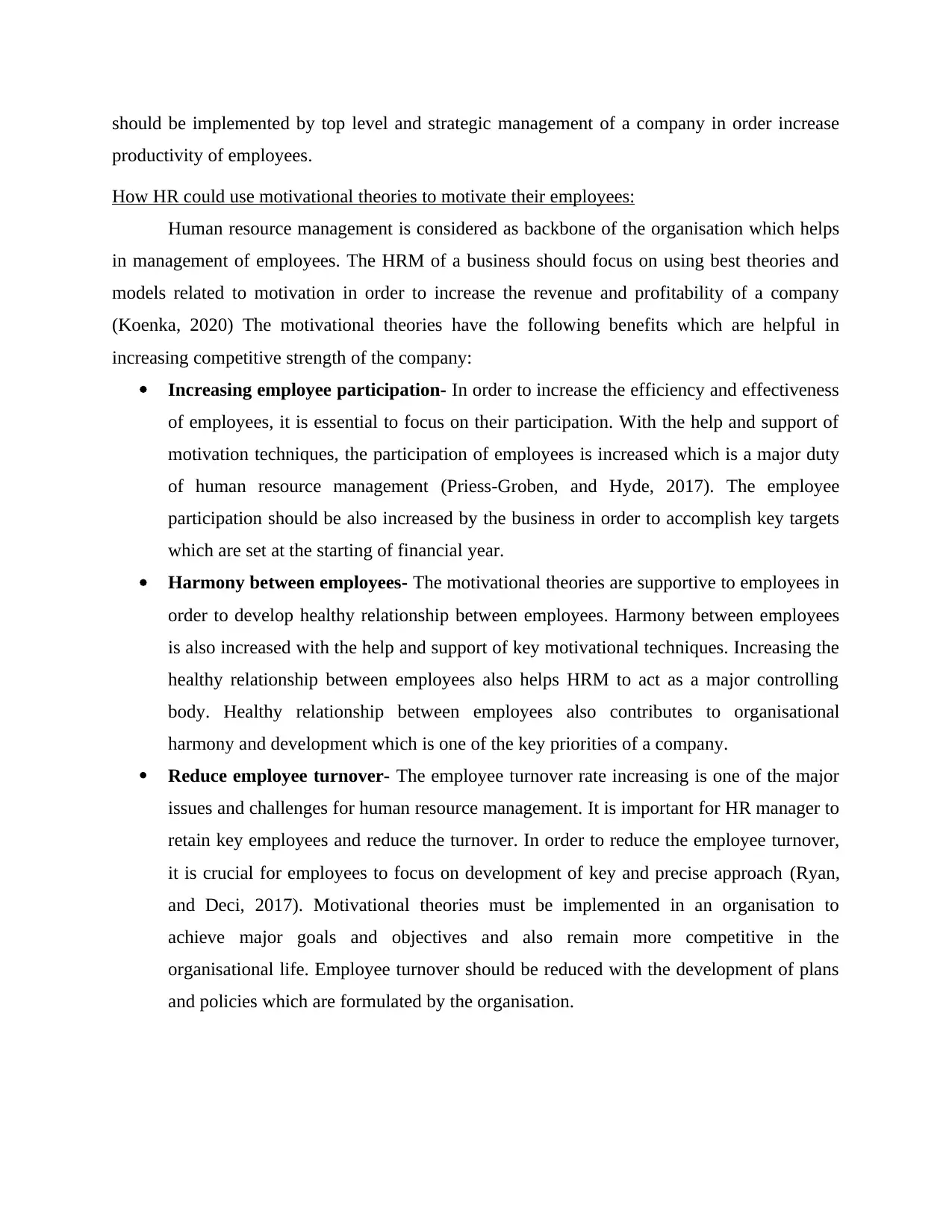
should be implemented by top level and strategic management of a company in order increase
productivity of employees.
How HR could use motivational theories to motivate their employees:
Human resource management is considered as backbone of the organisation which helps
in management of employees. The HRM of a business should focus on using best theories and
models related to motivation in order to increase the revenue and profitability of a company
(Koenka, 2020) The motivational theories have the following benefits which are helpful in
increasing competitive strength of the company:
Increasing employee participation- In order to increase the efficiency and effectiveness
of employees, it is essential to focus on their participation. With the help and support of
motivation techniques, the participation of employees is increased which is a major duty
of human resource management (Priess-Groben, and Hyde, 2017). The employee
participation should be also increased by the business in order to accomplish key targets
which are set at the starting of financial year.
Harmony between employees- The motivational theories are supportive to employees in
order to develop healthy relationship between employees. Harmony between employees
is also increased with the help and support of key motivational techniques. Increasing the
healthy relationship between employees also helps HRM to act as a major controlling
body. Healthy relationship between employees also contributes to organisational
harmony and development which is one of the key priorities of a company.
Reduce employee turnover- The employee turnover rate increasing is one of the major
issues and challenges for human resource management. It is important for HR manager to
retain key employees and reduce the turnover. In order to reduce the employee turnover,
it is crucial for employees to focus on development of key and precise approach (Ryan,
and Deci, 2017). Motivational theories must be implemented in an organisation to
achieve major goals and objectives and also remain more competitive in the
organisational life. Employee turnover should be reduced with the development of plans
and policies which are formulated by the organisation.
productivity of employees.
How HR could use motivational theories to motivate their employees:
Human resource management is considered as backbone of the organisation which helps
in management of employees. The HRM of a business should focus on using best theories and
models related to motivation in order to increase the revenue and profitability of a company
(Koenka, 2020) The motivational theories have the following benefits which are helpful in
increasing competitive strength of the company:
Increasing employee participation- In order to increase the efficiency and effectiveness
of employees, it is essential to focus on their participation. With the help and support of
motivation techniques, the participation of employees is increased which is a major duty
of human resource management (Priess-Groben, and Hyde, 2017). The employee
participation should be also increased by the business in order to accomplish key targets
which are set at the starting of financial year.
Harmony between employees- The motivational theories are supportive to employees in
order to develop healthy relationship between employees. Harmony between employees
is also increased with the help and support of key motivational techniques. Increasing the
healthy relationship between employees also helps HRM to act as a major controlling
body. Healthy relationship between employees also contributes to organisational
harmony and development which is one of the key priorities of a company.
Reduce employee turnover- The employee turnover rate increasing is one of the major
issues and challenges for human resource management. It is important for HR manager to
retain key employees and reduce the turnover. In order to reduce the employee turnover,
it is crucial for employees to focus on development of key and precise approach (Ryan,
and Deci, 2017). Motivational theories must be implemented in an organisation to
achieve major goals and objectives and also remain more competitive in the
organisational life. Employee turnover should be reduced with the development of plans
and policies which are formulated by the organisation.
⊘ This is a preview!⊘
Do you want full access?
Subscribe today to unlock all pages.

Trusted by 1+ million students worldwide
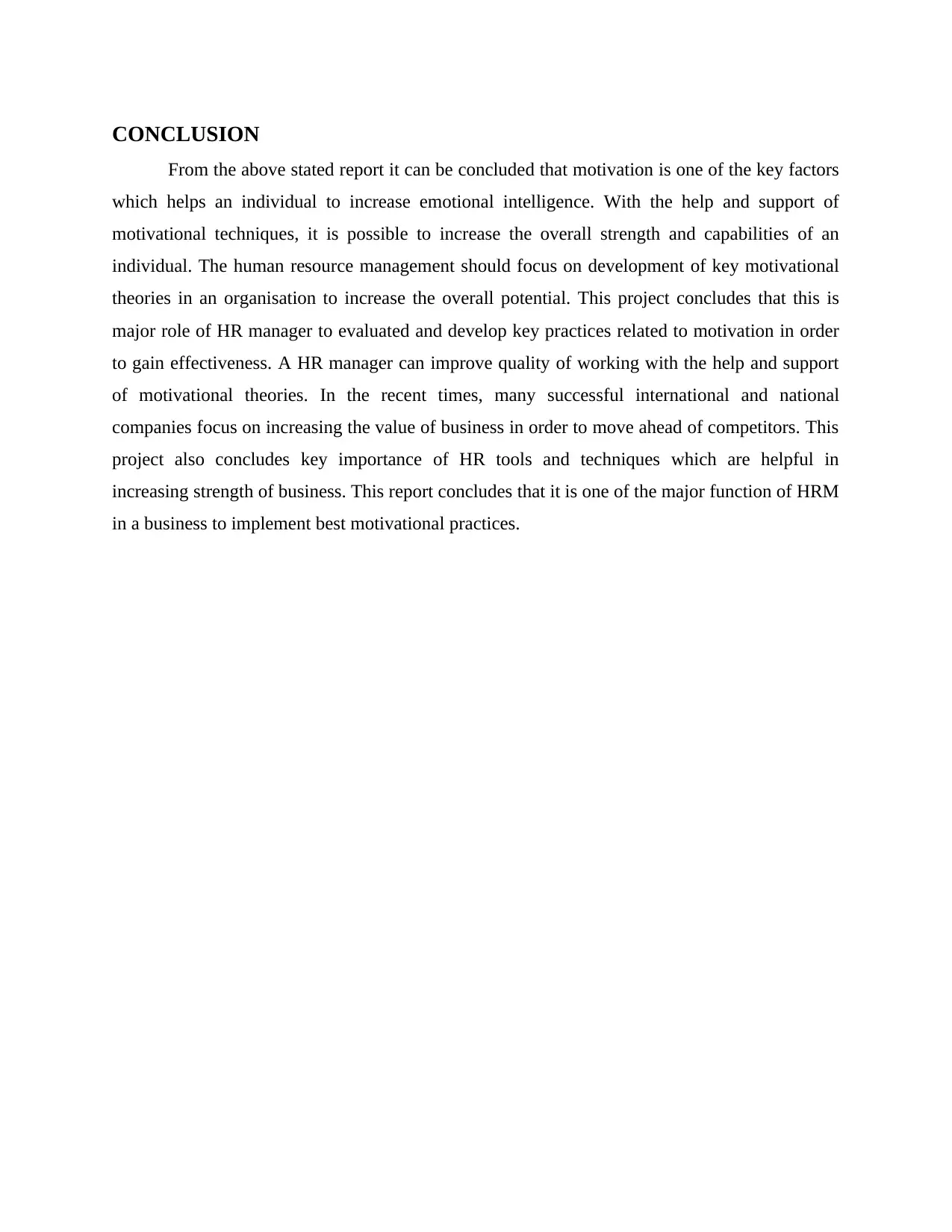
CONCLUSION
From the above stated report it can be concluded that motivation is one of the key factors
which helps an individual to increase emotional intelligence. With the help and support of
motivational techniques, it is possible to increase the overall strength and capabilities of an
individual. The human resource management should focus on development of key motivational
theories in an organisation to increase the overall potential. This project concludes that this is
major role of HR manager to evaluated and develop key practices related to motivation in order
to gain effectiveness. A HR manager can improve quality of working with the help and support
of motivational theories. In the recent times, many successful international and national
companies focus on increasing the value of business in order to move ahead of competitors. This
project also concludes key importance of HR tools and techniques which are helpful in
increasing strength of business. This report concludes that it is one of the major function of HRM
in a business to implement best motivational practices.
From the above stated report it can be concluded that motivation is one of the key factors
which helps an individual to increase emotional intelligence. With the help and support of
motivational techniques, it is possible to increase the overall strength and capabilities of an
individual. The human resource management should focus on development of key motivational
theories in an organisation to increase the overall potential. This project concludes that this is
major role of HR manager to evaluated and develop key practices related to motivation in order
to gain effectiveness. A HR manager can improve quality of working with the help and support
of motivational theories. In the recent times, many successful international and national
companies focus on increasing the value of business in order to move ahead of competitors. This
project also concludes key importance of HR tools and techniques which are helpful in
increasing strength of business. This report concludes that it is one of the major function of HRM
in a business to implement best motivational practices.
Paraphrase This Document
Need a fresh take? Get an instant paraphrase of this document with our AI Paraphraser
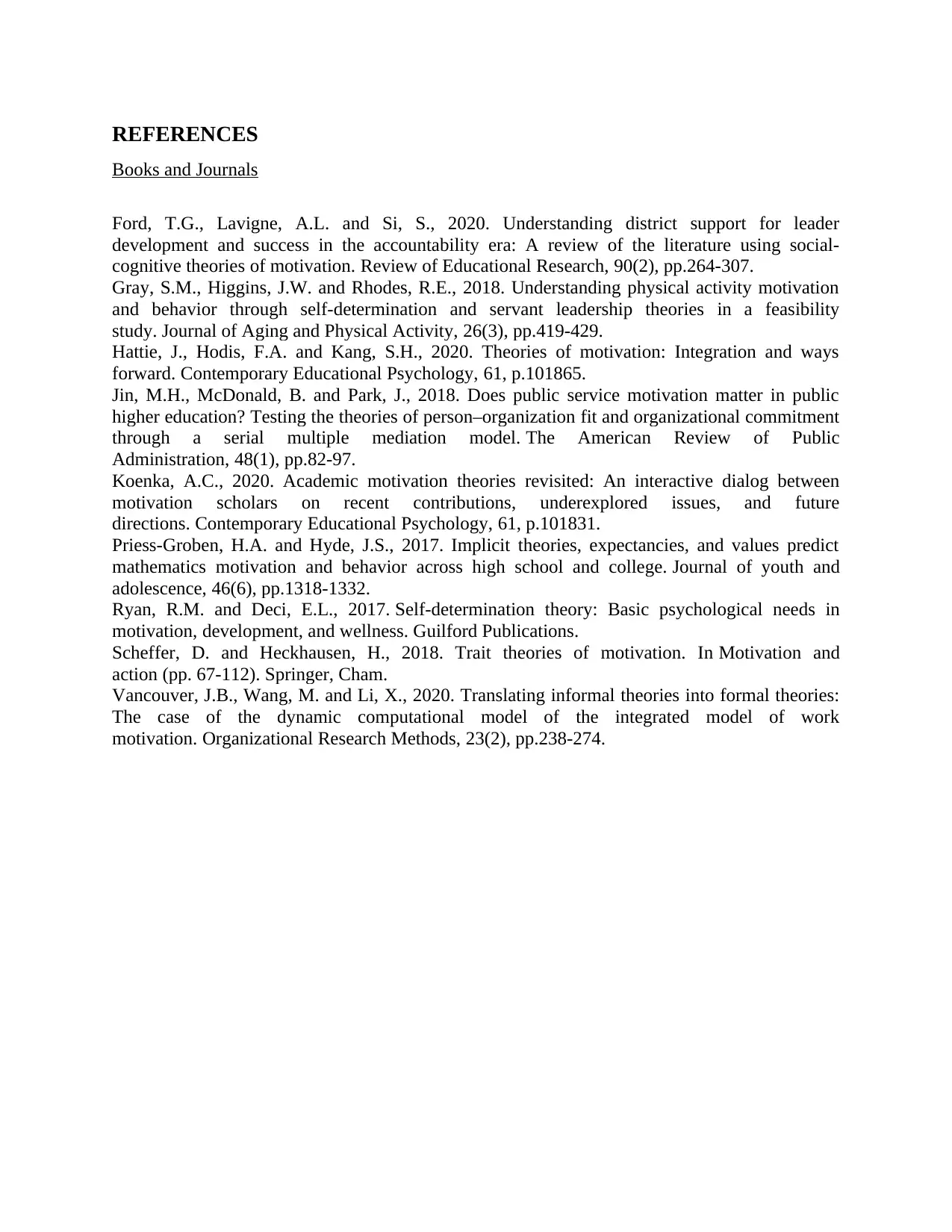
REFERENCES
Books and Journals
Ford, T.G., Lavigne, A.L. and Si, S., 2020. Understanding district support for leader
development and success in the accountability era: A review of the literature using social-
cognitive theories of motivation. Review of Educational Research, 90(2), pp.264-307.
Gray, S.M., Higgins, J.W. and Rhodes, R.E., 2018. Understanding physical activity motivation
and behavior through self-determination and servant leadership theories in a feasibility
study. Journal of Aging and Physical Activity, 26(3), pp.419-429.
Hattie, J., Hodis, F.A. and Kang, S.H., 2020. Theories of motivation: Integration and ways
forward. Contemporary Educational Psychology, 61, p.101865.
Jin, M.H., McDonald, B. and Park, J., 2018. Does public service motivation matter in public
higher education? Testing the theories of person–organization fit and organizational commitment
through a serial multiple mediation model. The American Review of Public
Administration, 48(1), pp.82-97.
Koenka, A.C., 2020. Academic motivation theories revisited: An interactive dialog between
motivation scholars on recent contributions, underexplored issues, and future
directions. Contemporary Educational Psychology, 61, p.101831.
Priess-Groben, H.A. and Hyde, J.S., 2017. Implicit theories, expectancies, and values predict
mathematics motivation and behavior across high school and college. Journal of youth and
adolescence, 46(6), pp.1318-1332.
Ryan, R.M. and Deci, E.L., 2017. Self-determination theory: Basic psychological needs in
motivation, development, and wellness. Guilford Publications.
Scheffer, D. and Heckhausen, H., 2018. Trait theories of motivation. In Motivation and
action (pp. 67-112). Springer, Cham.
Vancouver, J.B., Wang, M. and Li, X., 2020. Translating informal theories into formal theories:
The case of the dynamic computational model of the integrated model of work
motivation. Organizational Research Methods, 23(2), pp.238-274.
Books and Journals
Ford, T.G., Lavigne, A.L. and Si, S., 2020. Understanding district support for leader
development and success in the accountability era: A review of the literature using social-
cognitive theories of motivation. Review of Educational Research, 90(2), pp.264-307.
Gray, S.M., Higgins, J.W. and Rhodes, R.E., 2018. Understanding physical activity motivation
and behavior through self-determination and servant leadership theories in a feasibility
study. Journal of Aging and Physical Activity, 26(3), pp.419-429.
Hattie, J., Hodis, F.A. and Kang, S.H., 2020. Theories of motivation: Integration and ways
forward. Contemporary Educational Psychology, 61, p.101865.
Jin, M.H., McDonald, B. and Park, J., 2018. Does public service motivation matter in public
higher education? Testing the theories of person–organization fit and organizational commitment
through a serial multiple mediation model. The American Review of Public
Administration, 48(1), pp.82-97.
Koenka, A.C., 2020. Academic motivation theories revisited: An interactive dialog between
motivation scholars on recent contributions, underexplored issues, and future
directions. Contemporary Educational Psychology, 61, p.101831.
Priess-Groben, H.A. and Hyde, J.S., 2017. Implicit theories, expectancies, and values predict
mathematics motivation and behavior across high school and college. Journal of youth and
adolescence, 46(6), pp.1318-1332.
Ryan, R.M. and Deci, E.L., 2017. Self-determination theory: Basic psychological needs in
motivation, development, and wellness. Guilford Publications.
Scheffer, D. and Heckhausen, H., 2018. Trait theories of motivation. In Motivation and
action (pp. 67-112). Springer, Cham.
Vancouver, J.B., Wang, M. and Li, X., 2020. Translating informal theories into formal theories:
The case of the dynamic computational model of the integrated model of work
motivation. Organizational Research Methods, 23(2), pp.238-274.
1 out of 8
Related Documents
Your All-in-One AI-Powered Toolkit for Academic Success.
+13062052269
info@desklib.com
Available 24*7 on WhatsApp / Email
![[object Object]](/_next/static/media/star-bottom.7253800d.svg)
Unlock your academic potential
Copyright © 2020–2025 A2Z Services. All Rights Reserved. Developed and managed by ZUCOL.


